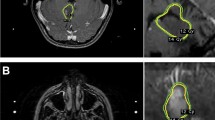Abstract
Purpose
Pilocytic astrocytoma (PA) is a World Health Organization grade I neoplasm that generally follows a benign course. However, in some patients, PA exhibits an aggressive clinical course. Here, we examined the clinical course of pediatric and adult PAs with progression at a single institution.
Methods
Between 1995 and 2013, 39 patients with PA were treated. Nineteen were pediatric patients (mean age, 12 years; range, 1–17 years) with a male-to-female patient ratio of 10:9, while 20 were adults (mean age, 36.4 years; range, 19–65 years) with a male-to-female ratio of 9:11. We analyzed and compared tumor location, extent of tumor resection, adjuvant treatment, and clinical course in all patients.
Results
In the 19 pediatric patients, tumors were located in the cerebellar vermis, cerebellar hemisphere, optic pathways plus hypothalamus, hypothalamus, brainstem, and the temporal lobe in 6 (31.6 %), 5 (26.3 %), 3 (15.8 %), 2 (10.5 %), and 2 (10.5 %) patients and 1 (5.3 %) patient, respectively. The mass was totally, subtotally, or partially resected in 11 (57.9 %), 2 (10.5 %), and 4 (21.1 %) patients, respectively; biopsies were performed in 2 (10.5 %) patients. Immediate postoperative adjuvant treatment was carried out in 6 patients. Tumor progression was detected in 3 patients at 3.0, 4.6, and 5.2 years after treatment, respectively, without significant symptoms. In the 20 adult patients, tumors were located in the cerebellar hemisphere, cerebellar vermis, hypothalamus, brainstem, cerebral hemisphere, and lateral ventricle in 5 (25 %), 4 (20 %), 3 (15 %), 3 (15 %), 3 (15 %), and 2 (10 %) patients, respectively. The mass was totally, subtotally, or partially resected in 11 (55 %) and 6 (30 %) patients and 1 (5 %) patient, respectively; biopsies were performed in 2 patients. Immediate adjuvant treatment was carried out in 2 patients. Progression was detected in 3 patients at 0.3, 0.9, and 2.5 years after treatment, respectively, with progressive neurologic symptoms. There was one case of disease-related mortality during follow-up among the adult patients.
Conclusion
Most of the PA cases evaluated in this study were benign. However, tumor progression in adult PAs followed a more aggressive clinical course than those in pediatric PAs.



Similar content being viewed by others
References
Scheithauer BW, Hawkins C, Tihan T, VandenBerg SR, Burger PC (2007) Pilocytic astrocyoma. In: Louis DN, Ohgaki H, Wiestler OD, Cavenee WK (eds) WHO classification of tumours of the central nervous system. IARC, Lyon, pp. 14–21
Burkhard C, Di Patre PL, Schuler D, Schuler G, Yasargil MG, Yonekawa Y, Lutolf UM, Kleihues P, Ohgaki H (2003) A population-based study of the incidence and survival rates in patients with pilocytic astrocytoma. J Neurosurg 98:1170–1174
Brown PD, Buckner JC, O'Fallon JR, Iturria NL, Brown CA, O'Neill BP, Scheithauer BW, Dinapoli RP, Arusell RM, Abrams RA, Curran WJ, Shaw EG, North Central Cancer Treatment Group, Mayo Clinic (2004) Adult patients with supratentorial pilocytic astrocytomas: a prospective multicenter clinical trial. Int J Radiat Oncol Biol Phys 58: 1153–1160
Ellis JA, Waziri A, Balmaceda C, Canoll P, Bruce JN, Sisti MB (2009) Rapid recurrence and malignant transformation of pilocytic astrocytoma in adult patients. J Neuro-Oncol 95:377–382
Ishkanian A, Laperriere NJ, Xu W, Millar BA, Payne D, Mason W, Sahgal A (2011) Upfront observation versus radiation for adult pilocytic astrocytoma. Cancer 117:4070–4079
Johnson DR, Brown PD, Galanis E, Hammack JE (2012) Pilocytic astrocytoma survival in adults: analysis of the Surveillance, Epidemiology, and End Results Program of the National Cancer Institute. J Neuro-Oncol 108:187–193
Stuer C, Vilz B, Majores M, Becker A, Schramm J, Simon M (2007) Frequent recurrence and progression in pilocytic astrocytoma in adults. Cancer 110:2799–2808
Afra D, Muller W, Slowik F, Firsching R (1986) Supratentorial lobar pilocytic astrocytomas: report of 45 operated cases, including 9 recurrences. Acta Neurochir 81:90–93
Bell D, Chitnavis BP, Al-Sarraj S, Connor S, Sharr MM, Gullan RW (2004) Pilocytic astrocytoma of the adult—clinical features, radiological features and management. Br J Neurosurg 18:613–616
Gnekow AK, Kortmann RD, Pietsch T, Emser A (2004) Low grade chiasmatic-hypothalamic glioma-carboplatin and vincristin chemotherapy effectively defers radiotherapy within a comprehensive treatment strategy—report from the multicenter treatment study for children and adolescents with a low grade glioma—HIT-LGG 1996—of the Society of Pediatric Oncology and Hematology (GPOH). Klin Padiatr 216:331–342
Dirven CM, Mooij JJ, Molenaar WM (1997) Cerebellar pilocytic astrocytoma: a treatment protocol based upon analysis of 73 cases and a review of the literature. Childs Nerv Syst 13:17–23
Bowers DC, Gargan L, Kapur P, Reisch JS, Mulne AF, Shapiro KN, Elterman RD, Winick NJ, Margraf LR (2003) Study of the MIB-1 labeling index as a predictor of tumor progression in pilocytic astrocytomas in children and adolescents. J Clin Oncol 21:2968–2973
Wong KK, Chang YM, Tsang YT, Perlaky L, Su J, Adesina A, Armstrong DL, Bhattacharjee M, Dauser R, Blaney SM, Chintagumpala M, Lau CC (2005) Expression analysis of juvenile pilocytic astrocytomas by oligonucleotide microarray reveals two potential subgroups. Cancer Res 65:76–84
Sharma MK, Watson MA, Lyman M, Perry A, Aldape KD, Deak F, Gutmann DH (2006) Matrilin-2 expression distinguishes clinically relevant subsets of pilocytic astrocytoma. Neurology 66:127–130
Parsa CF, Givrad S (2008) Juvenile pilocytic astrocytomas do not undergo spontaneous malignant transformation: grounds for designation as hamartomas. Br J Ophthalmol 92:40–46
Acknowledgments
This study was supported by the Basic Science Research Program through the National Research Foundation of Korea (NRF), funded by the Ministry of Science, ICT and Future Planning (2014R1A1A1004469).
Conflict of interest
The authors report no conflicts of interest. The authors alone are responsible for the content and writing of the paper.
Author information
Authors and Affiliations
Corresponding author
Rights and permissions
About this article
Cite this article
Ryu, HH., Jung, TY., Lee, GJ. et al. Differences in the clinical courses of pediatric and adult pilocytic astrocytomas with progression: a single-institution study. Childs Nerv Syst 31, 2063–2069 (2015). https://doi.org/10.1007/s00381-015-2887-z
Received:
Accepted:
Published:
Issue Date:
DOI: https://doi.org/10.1007/s00381-015-2887-z




